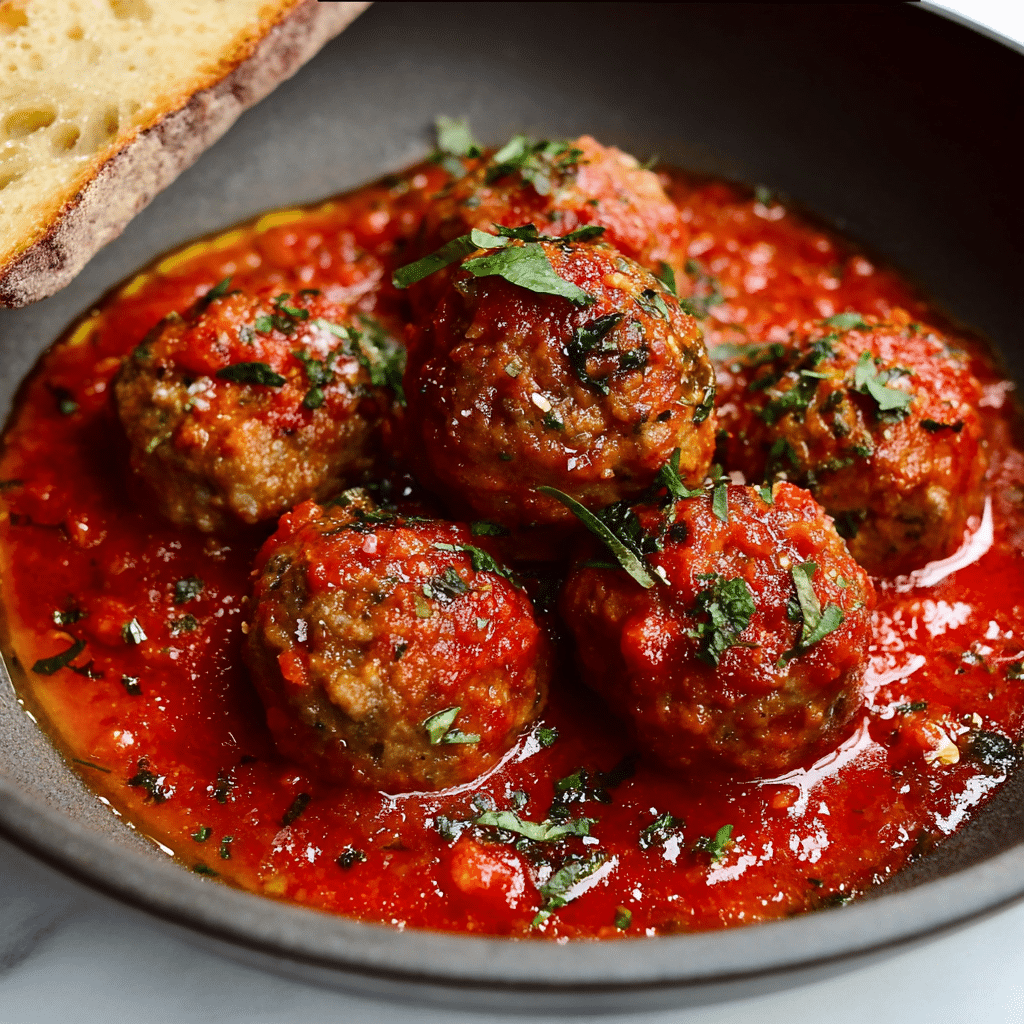Serve these juicy meatballs nestled in a pool of vibrant tomato sauce, garnished with a sprinkle of fresh parsley and grated Parmesan, for a dish that feels like a warm hug from nonna. The rustic skillet presentation makes an inviting centrepiece, perfect for family-style sharing.
This recipe embodies the essence of Italian comfort cooking—simple ingredients layered with flavor and tradition. Whether you’re feeding a crowd or craving cozy, this dish delivers soul-soothing satisfaction, especially when paired with crusty bread to mop up that luscious sauce.
Full Recipe
Ingredients:
-
½ lb ground beef
-
½ lb ground pork
-
½ cup breadcrumbs
-
⅓ cup milk
-
¼ cup finely grated Parmesan
-
1 large egg
-
2 cloves garlic, minced
-
2 tbsp fresh parsley, chopped
-
1 tsp dried oregano
-
½ tsp salt
-
¼ tsp black pepper
-
2 tbsp olive oil
-
1 jar (24 oz) quality marinara sauce
Directions:
-
In a small bowl, soak breadcrumbs in milk for 5 minutes until moistened.
-
In a large bowl, combine meats, soaked breadcrumbs, Parmesan, egg, garlic, parsley, oregano, salt, and pepper. Mix gently until just combined.
-
Shape mixture into 16 equally sized meatballs (about 1½” each).
-
Heat olive oil in a wide skillet over medium heat. Brown meatballs on all sides, about 6–8 minutes.
-
Pour marinara sauce over meatballs, reduce heat to low, cover, and simmer for 20 minutes until cooked through.
-
Serve hot over pasta, polenta, or in a crusty roll.
Prep Time: 15 minutes | Cooking Time: 30 minutes | Total Time: 45 minutes
Kcal: approx. 350 kcal per serving | Servings: 4
The Story Behind Italian Meatballs
Italian meatballs, or polpette, have become a cherished comfort food across cultures. While many associate them with spaghetti, traditional Italian cuisine often enjoys meatballs as a standalone dish, served with a rich tomato sauce or eaten as appetizers. This specific version, combining ground beef and pork, hails from Southern Italy and showcases a delicate balance of flavor, texture, and aroma.
Historically, meatballs were created as a way to stretch ingredients further, using day-old bread, milk, and herbs to bulk up minced meat. This approach transformed a humble pantry into a delicious meal that fed entire families—nourishing body and soul. Italian immigrants brought this recipe to America in the late 19th century, adapting it to local ingredients and preferences. Over time, it evolved into the saucy meatball-spaghetti combo widely popular today.
Why This Version Stands Out
What sets these Italian meatballs apart is their tender texture, achieved through a clever combination of breadcrumbs soaked in milk, and the blend of beef and pork for richness and juiciness. The use of Parmesan cheese and fresh parsley adds layers of umami and freshness, while garlic and oregano round out the flavor profile with a robust Italian flair.
Searing the meatballs before simmering in marinara sauce creates a caramelized crust that locks in flavor and elevates the dish. This dual-cooking method is essential for achieving meatballs that are crispy on the outside yet soft and moist inside.
Pairing and Serving Suggestions
These meatballs are incredibly versatile. While traditionally served on their own or with crusty Italian bread, they can be enjoyed in multiple ways. Try spooning them over creamy polenta for a rustic meal, nestling them into a sub roll for a meatball sandwich, or pairing them with spaghetti for a beloved classic.
For a low-carb option, serve them over zucchini noodles or spaghetti squash. Add a side salad of arugula and shaved Parmesan with lemon vinaigrette for a complete, satisfying meal.
Tips for Perfect Meatballs Every Time
Achieving the perfect meatball is as much about method as it is about ingredients. First, avoid overmixing the meat mixture—this can make the meatballs tough. Mix gently until just combined.
Use a cookie scoop or wet your hands when forming the meatballs to ensure uniform size and prevent sticking. Consistent sizing helps them cook evenly and prevents overcooking smaller ones while waiting for the larger ones to finish.
Finally, don’t skip the browning step. Though you could technically drop the raw meatballs directly into the sauce to simmer, browning them first in olive oil creates a flavor-packed crust that enhances the final dish significantly.
Making It Ahead and Storing
These Italian meatballs are ideal for meal prep. You can make a double batch and freeze them either before or after cooking. If freezing raw, place them on a baking sheet in a single layer until solid, then transfer to a freezer-safe container. When ready to use, defrost overnight and cook as directed.
Cooked meatballs in sauce also freeze beautifully. Just cool completely, portion into containers, and freeze for up to 3 months. When you need a quick dinner, reheat gently on the stovetop or in the microwave.
Nutritional Value and Dietary Considerations
This dish is naturally high in protein and provides essential vitamins from the meat, such as B12 and iron. Adding Parmesan introduces calcium, while using whole ingredients keeps preservatives and additives out.
For those on gluten-free diets, the recipe can be adapted easily by using gluten-free breadcrumbs. Lactose-intolerant or dairy-free individuals can substitute the milk with a plant-based option and either omit the Parmesan or use a dairy-free alternative.
Cultural Significance
Though often “Americanized,” the soul of Italian meatballs remains deeply rooted in tradition. In Italy, meatballs are a reflection of familial warmth and generational cooking. They’re often reserved for Sunday meals or special occasions, symbolizing love, comfort, and togetherness.
In many Italian homes, the recipe is passed down through generations, often unwritten and memorized through years of cooking side-by-side with nonna (grandmother). Every family has its own slight variation, whether it’s a dash of nutmeg, the inclusion of raisins, or the choice of meats. These subtle differences make the recipe feel personal and sacred.
Making It Your Own
While the classic beef and pork combination is hard to beat, there’s room to play with flavors and make this dish your own. Try adding a pinch of crushed red pepper flakes for heat or experiment with fresh herbs like basil or thyme. You can even stuff the meatballs with a cube of mozzarella for a gooey surprise in the center.
Vegetarians can enjoy a similar experience by replacing the meat with a combination of mashed chickpeas, mushrooms, and lentils, still flavored with the same herbs and cheese for authenticity.
Why Homemade Always Wins
While store-bought meatballs may offer convenience, homemade ones deliver unparalleled flavor and texture. Making them yourself allows you to control every ingredient—cutting out excess sodium, preservatives, and mystery fillers. Plus, it gives you the opportunity to season and taste to your liking.
There’s also a kind of joy and satisfaction that comes from forming the meatballs by hand, watching them brown in the pan, and letting them slowly simmer in sauce until your kitchen smells like an Italian trattoria. It turns a simple meal into a memorable ritual.
Conclusion
Italian meatballs are more than just a dish—they’re a celebration of culture, history, and family. From their humble beginnings to their star role in dinner tables across the world, they’ve stood the test of time for good reason. Rich in flavor and steeped in tradition, this recipe offers both nourishment and nostalgia.
Whether you’re a seasoned cook or just starting your culinary journey, mastering this dish will add a timeless classic to your repertoire. Serve it up with love, and watch as it becomes a family favorite for generations to come.






